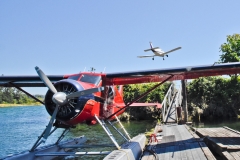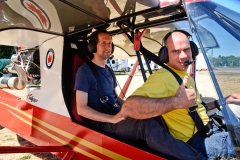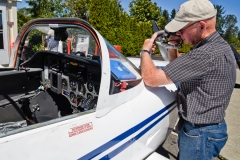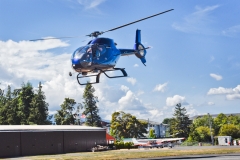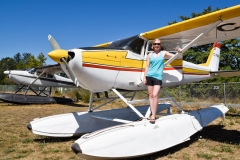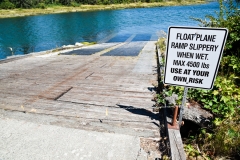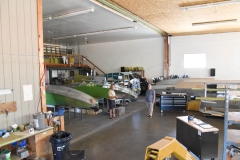
by George Le Masurier | Sep 3, 2018
Courtenay City Council candidate Brennan Day believes that with good planning, the Comox Valley can grow without without losing its charm or small town feel. He would improve infrastructure, housing affordability and promote greater City Council transparency and better communication
Brennan Day believes the silent majority is under-represented on the Courtenay City Council, but that’s not the only reason he’s running for office this year.
He wants to make housing more affordable, properly plan for population growth, ensure the city spends its money wisely, improve infrastructure and create more transparency in local government.
As a 25-year resident who was raised in the Comox Valley, Day understands the desire to maintain the small town characteristics that people love. He just doesn’t see that as mutually exclusive with what he regards as inevitable growth.
“We can’t pretend the Valley won’t continue to grow,” he said. “If we do, and bury our heads in the sand, we’ll get sprawl. But if we plan for growth, we can improve infrastructure so that the community still feels small.”
Day and his wife, a former Denman Island resident, and their one-year-old child moved back to the Valley in 2016, after spending the previous 10 years living and working in Kazakhstan. He worked as a manager for Arctic Group International, which specializes in services for Kazakhstan’s oil and gas industry.
Day currently works for Hyland Precast in Cumberland.
FURTHER READING: Who is running for municipal office this year, go to our Elections 2018 page.
The Valley’s infrastructure lags behind neighboring communities like Campbell River, according to Day, because we’re not recognized as an urban center and split into smaller municipal populations.
“This should concern everyone, because we’re missing out on federal and provincial funding as a result,” he said. “We don’t get a proportional return on our taxes.”
Day isn’t promoting amalgamation, but he sees considerable savings in consolidating services such as fire departments and parks.
“I believe City Council has to be responsible with tax dollars,” he said. “We’re currently overspending for the services we get. Consolidating services could be a transitional step to lowering the tax burden.”
Describing himself as a moderate fiscal conservative, which he believes mirrors the majority of Courtenay residents, Day disagreed with the City Council’s recent decision to hire more employees, because the process was flawed.
“Their methodology was okay, acceptable,” he said. “But there was no attempt to look at spending accounts first.”
With a windfall surplus, he said City Council “seemed desperate to spend it rather than cut taxes.” Had council looked harder at expense accounts, Day says he might have approved the hirings.
The candidate points to the aging Fifth Street bridge as an example of the city’s failure to plan for infrastructure improvement.
“That bridge is about 30 years past its life cycle, and we’re going to have to replace it,” he said. “What are we going to do when it no longer passes safety inspections?”
Day believes a third crossing of the Courtenay River will eventually be needed, but says the city should work with the province to make improvements to the 17th Street bridge first.
While City Council has to consider all available options, he thinks a new bridge at 21st St. that would close the Courtenay Airpark should be the lowest priority.
And the city could avoid miscommunications with citizens like the Courtenay Airpark Association if the council was more transparent. He calls the council’s communication efforts “terrible.”
Day would advocate for more robust minutes that show how each council member voted in all decisions, not just those motions that fail.
“If elected, I would publicize a position piece on every vote I cast,” he said. “People should know why council members voted the way they did.”
And he would restrict in-camera sessions because they “don’t give the public confidence.”
Day would also support efforts to make housing more affordable in the city, including allowing carriage houses and suites without going through an amendment process, and other easy steps to densify the urban core.
“These things can get us to the goal quicker,” he said. “And they have a smaller impact than putting up high rise buildings.”
Day would also promote creating more industrial development land, which he says is in short supply.
“Industrial land is scattered around and about half of it is covered by mini-storage operations,” he said. “If it doesn’t exist, where are the new jobs going to go?”

by George Le Masurier | Aug 20, 2018
PHOTO: Andreas Ruttkiewicz and student pilot land an ultralight at the Courtenay Airpark. Ruttkiewicz runs the Air Speed High Ultralight flight school at the airpark.
Courtenay abandons 21st Street river crossing thanks to Mayor Jangula, but city staff and council temporarily ground his proposal to give long-term certainly to airpark business owners at Monday’s meeting
This article was expanded Tuesday (Aug. 21) morning to add a response from the Airpark Association suggesting that Councillor Lennox made an erroneous statement regarding the airpark’s tax status.
Courtenay Mayor Larry Jangula took a conciliatory approach Monday night to concerns raised by members of the Airpark Association and successfully landed a unanimous agreement from council to abandon all discussions of a third river crossing at 21st Street.
But his attempt to address the larger issue of the airpark’s long-term viability crashed on takeoff.
A city proposal for a road through the airpark leading to a bridge through Hollyhock Marsh, and staff comments that all airpark leases would be converted to a month-to-month basis, has angered Courtenay Airpark Association members and aviation business owners.
FURTHER READING: Courtenay mayor fails to assuage airpark closure fears; Courtenay airpark touts its economic, lifestyle benefits; Battle brewing over city’s transportation master plan; City bridge proposal would harm airpark, Kus-kus-sum
They see the two issues as an attempt by the city to shut down the airpark.
Jangula tried to calm the airpark association’s fears last week, but his comments fell short.
This week, Jangula stepped down from the mayor’s chair to clarify his position with a motion that City Council officially abandon all consideration of a bridge at 21st Street. It passed unanimously.
Then Jangula tackled the bigger issue and proposed that the city offer the Airpark Association and aviation businesses 25-40 year leases on the city-owned property.
That got applause from the standing-room only audience, but less support from city staff and several council members.
Chief Administrative Officer David Allen derailed Jangula’s intentions to give the airpark immediate long-term assurances by suggesting council wait for city staff to do a report on the viability of offering long-term leases.
Councillor Doug Hillian made a motion to direct staff to do such a report, preferably by the Sept. 4 meeting, which passed, but not without some hesitation by councillors David Frisch, Rebecca Lennox and Hillian.
Hillian said council has “a responsibility to consider the implications of long-term use of city-owned properties.”
Frisch and Lennox seemed more reluctant in their comments. At one point, Lennox even referenced the Airpark Associations “tax-free status,” which is an erroneous statement, according to association president Morris Perrey.
“She is totally wrong,” Perrey said. “The businesses pay land taxes and lease fees and all the fees that every business pays, all the city insurance costs, everything and the city still gets their fees.”
Perrey said because the Airpark Association is a society and not supposed to pay taxes, the city charges the association fees in lieu, which have increased about 15 percent in the last five years.
Earlier in the meeting, Frisch appeared opposed to taking a 21st Street bridge off the table, although he ultimately voted in favor.
“We still have to move people around,” he said, referring to growing traffic congestion around the 17th St. and Fifth St. bridges.
CAO Allen said one of city staff’s strategic priorities for 2016-2018 is to assess city-owned land, and they have already identified several properties to start the review. He said it would be a “long and rigorous” process, and that discussions have already taken place in-camera.
Besides Jangula, two other council members, Bob Wells and Hillian, apologized to Airpark Association members.
Hillian called the public document showing a bridge through the airpark a ”mistake.”
Wells apologized for “the angst, stress and uncertainty we’ve put people through.”
He said the city acted without full consideration of how the 21st Street crossing proposal impacted the aviation community.
CAO Allen said the bridge proposal was never expected to be a fait accompli, and a staff member said the idea arose from the public consultation process about the city’s transportation plan.
That staff member termed the consultation process a “success” because it got the strong reaction from the Airpark Association. That comment caused eye-rolling murmurs among the audience.
Finally, Jangula made a motion to break from the agenda and let Airpark Association spokesman Dave Mellin speak and respond to the council discussion so far. That required a two-thirds vote, which it received, with Lennox and Frisch opposing it.
Referring to the uncertainty of short-term leases, Mellin said jobs and job security were on the line. Up to 90 people are employed at the airpark, depending on the season.
He said several business expansion plans have been stalled by council’s lack of clarity, and that five-year leases are of no value to the aviation businesses seeking long-term security.
“People are hanging out on a limb here,” he said.

by George Le Masurier | Aug 7, 2018
PHOTO: Dave Mellin inspects a de Havilland Beaver float plane being reconstructed at International Aeroproducts Inc., a widely known business in the aviation community located at the Courtenay Airpark
Courtenay Airpark Association members say City Council members don’t fully appreciate the depth of their concerns and were disappointed Mayor Larry Jangula didn’t “clear the air” and give them unequivocal support
The Courtenay Airpark Association told its story to City Council Tuesday afternoon, of how the aviation community benefits the community, as a means of ferreting out the city’s long-term intentions for the Airpark.
But council members either didn’t fully comprehend the association’s concerns or they are not as committed to preserving and supporting the Airpark as they were when writing the 2016 Official Community Plan (OCP).
Courtenay Airpark Association (CAA) President Morris Perrey hoped the meeting would give aviation business owners and private aircraft owners clarity about their future. Fears that the city is trying to close the Airpark run deeply through the association, and among pilots around the B.C. coast who use the airport.
He was disappointed that didn’t happen because of what appears to be a disconnect between council and city staff.
Council apparently thought the issue was only a third crossing proposal that would dissect the Airpark, when the real issue is what association members perceive as a broader, coordinated scheme of small steps to squeeze the Airpark out of existence.
FURTHER READING: Who is trying to close the Airpark?
In response to a presentation made by Dave Mellin on behalf of the CAA, several council members downplayed the so-called “Option B” in the proposed 2018 update to the city’s Master Transportation Plan.
That option shows a third crossing that runs a road through the Airpark and a new bridge through the middle of a provincially protected wetlands in the heart of the K’omoks Estuary, known as Hollyhocks Marsh.
Council member and mayoral candidate David Frisch said the 21st Street crossing idea was not much more than an arrow on a map.
“I think we’re getting ahead of ourselves here,” he said, referring to, in part, the concerns of an overflow crowd of Airpark supporters spilling out of the council chambers.
Councillor Doug Hillian said he was as surprised as the association’s members to learn about the 21st Street proposal, and said he had no intention of jeopradizing the Airpark or the estuary.
“Sometimes mistakes are made,” he said. “This is one.”
Council members kept their remarks brief so Mayor Larry Jangula could read a prepared statement, which he prefaced by saying it would answer all their concerns.
Except it didn’t.
Jangula addressed the third bridge crossing by saying it was only a study and that no part of the plan, including the 21st Street bridge, would become reality without extensive stakeholder process and council’s approval.
But he did not say that “Option B” was off the table.
And he added a claim that no commercial or private tenants on the Airpark had been converted to month-to-month leases. The city was merely trying to align all the various leases to expire at the same time for administration efficiency.
That caused rumblings in the audience and prompted Mellin to contradict the mayor.
“We have several people in the audience who are on month-to-month leases now,” he said. “I can have them come up (to speak).”
It was obvious the council had misjudged the mood of the CAA and its supporters.
“The mayor had an opportunity to clear the air and put this to rest,” said Dave Bazett, a land surveyor who owns a building in the 21st Street path and hangars two aircraft that he uses for his land surveying business. “But he didn’t do it.”
Bazett said association members wanted to hear council say they will protect and encourage growth at the Airpark, as per their OCP, and “despite what pilots may have heard from staff, council supports you.”
“Instead, we got a rather aggressive statement (from the mayor),” Bazett said, adding that it seemed like Jangula was blaming staff for the disconnect.
And Bazett said in an earlier private phone conversation with Jangula, the mayor said the Airpark was going to get developed sooner or later.
Decafnation asked Jangula about that conversation, but he has yet to reply.
Several association members pondered whether city staff was going in a direction of shutting down the Airpark without the full consent of a divided City Council.
CAA President Perrey said that Courtenay Chief Administrative Officer Dave Allen told him, with two other association members present, that all leases were going on a month-to-month basis when their terms come up.
Allen is currently on summer vacation.
From the association’s perspective the monthly leases, the bridge proposal, denials of commercial building expansion and construction, red tape that has stalled float plane ramp reconstruction and other issues all add up to an effort to close the Airpark.
Perrey said the CAA didn’t get the clarity and unequivocal support they had hoped from City Council.
“This is going to be an election issue, for sure,” he said, reiterating a statement Mellin made during his presentation.
FURTHER READING: Battle brewing over transportation plan; City bridge proposal would harm Airpark, Kus-kus-sum

by George Le Masurier | Aug 7, 2018
The Courtenay Airpark Association believes the city is trying to close down this unique facility on the Vancouver Island coast. In a presentation to City Council today, Airpark volunteers will detail its economic, social and lifestyle benefits for the community
Editor’s note: this story was updated at 9 a.m. to include a Medivac helicopter landing at the Airpark last night due to unfavorable conditions at the hospital heli-pad.
Fearing that someone at Courtenay City Hall wants to turn the Airpark into a condo development, pilots and aviation business owners will pitch the facility’s economic benefits at 4 p.m. today (Aug. 7) to the City Council.
Closing the Courtenay Airpark would shutter several aviation businesses and put roughly 50 people out of work, not to mention the estimated indirect loss of more than $20 million in spin-off economic activity, social benefits and the displacing of 72 private aircraft to other Island communities.
So who is trying to close the Airpark?
Mo Perry, president of the Courtenay Airpark Association, isn’t sure. But he says the signals started well before city staff released a proposed update to its transportation plan that shows a new bridge going directly through the Airpark.
The city, which owns the Airpark land, has been converting leases for aviation businesses, hangars and the volunteer association that runs the aerodrome from a five-year term to month-to-month.
“No business can operate on month-to-month leases successfully,” Perry says. “The uncertainty stifles investment and growth.”
Al Pheaton’s International Aeroproducts Inc. employs 15 tradesmen and up to 30 during the busy winter months fabricating floats for seaplanes and during major restorations of Beaver and Otter aircraft. It’s known worldwide in the aviation community as one of the best in the business.
Pheaton’s business is so successful that he needs to expand his floorspace either into a second, separate building or by adding on to the existing one. But he can’t get approval from the City of Courtenay.
“And anyway, what bank is going to loan money to a business for expansion on a month-to-month lease,” Perry said.
FURTHER READING: Battle brewing over transportation plan; City bridge proposal would harm Airpark, Kus-kus-sum
The Courtenay Airpark is unique in British Columbia because it is accessible for both wheel and float planes. Pilots can bring their floatplanes in for repair and leave via wheeled planes.
But the city has been stalling a long, overdue restoration of the float plane ramp, despite provincial and federal support and approval for the project.
So when the proposed transportation plan update came out with a road and bridge through the Airpark’s runway, Perry said the city’s plan became obvious.
But Airpark volunteers don’t know who at city hall is trying to drive them out.
Current Mayor Larry Jangula and the three mayoralty candidates — David Frisch, Erik Eriksson and Bob Wells — have all previously told Decafnation that Airpark volunteers and business owners shouldn’t worry about the proposed third crossing at 21st Street.
“It’s just a concept,” Jangula said.
Decafnation emails Jangula and the three mayoralty candidates yesterday (Aug. 6) and asked if they were in favor of closing the Courtenay Airpark and using the land for some other purpose:
Eriksson said, “I like the Airpark.”
Frisch said, “That question has too many unknowns to give a yes or no answer. I do value the airpark amenity, but I must stay open to all possibilities for this city owned asset.”
Wells and Jangula did not reply.
Other organizations, like Project Watershed, are also alarmed by the 21st Street bridge proposal. A roadway and bridge there would slice Hollyhock Marsh in half and affect the group’s future restoration of the old Field’s Sawmill site, known now as Kus-kus-sum. The group has said it would oppose any crossing south of 17th Street.
Comox Valley Nature President Jim Boulter has said his organization is also opposed to the 21st Street bridge proposal.
Hollyhock Marsh is provincially owned and protected land, so it’s somewhat unlikely the city would be allowed to build a bridge through it.
But Perry and other Airpark volunteers, like Dave Mellin, worry that abandoning the bridge proposal won’t diminish the city’s attacks on the Airpark despite its 2016 Official Community Plan that requires council to “protect the integrity of the airpark and marina facilities at 20th Street; work with non-profit societies to improve and expand facilities as required.”
“The Airpark is the only park owned by the city that actually generates revenue,” Perry said. “All of their other parks cost the city money.”
WHAT’S AT STAKE
The Airpark was originally built by local pilots in the early 1960s. Eric Franklin was the first pilot to land there — on a gravel runway — in September of 1964.
Since its origin 55 years ago, all the improvements to the facility — except for provincial grants for paving the runway and installing an underground fuel system — have been funded from Airpark revenue or through volunteers.
Airpark businesses that include aircraft maintenance, flight schools and timber cruising have created up to 50 direct jobs and roughly 90 indirect jobs, producing about $50,000 in revenue annually for the city.
More than 700 student pilots and in excess of 200 air force cadets have completed their training at the Airpark. There are two Ministry of Transport approved flight schools on site.
The RCMP use the Airpark regularly, and it will continue to be used for patient transfers on Medivac flights because certain weather conditions will impede landing at the new hospital. A Medivac helicopter landed at the Airpark at 6 p.m. last night (aug. 6) because conditions at the hospital helipad were unfavorable.
“Can’t imagine landing on that hospital heli-pad on a typical Comox Valley blistery winter day with a loaded chopper,” Perry said.
In the event of an emergency, such as an earthquake, the Airpark is the only facility on the west side of the river for evacuation or medical transportation if bridges and roads are disabled.
CFB Comox 4 Construction Engineering Squadron does annual testing of the Airpark runway to ensure that it’s safe for certain military air operations if needed, such as Buffalo and helicopters.
WHO USES THE AIRPARK
Andreas Ruttkiewicz, a former military jet pilot, runs the Air Speed High Ultralight flight school. He started his business in 2007 in Victoria and moved it to Comox in 2011. He trains about 12 to 15 pilots a year.
Sealand Flight, a pilot training and aircraft rental company based in Campbell River, plans to open a Courtenay operation this month. It trains pilots for recreational, private and commercial certification.
International Aeroproducts Inc. is currently doing a complete restoration of a classic Beaver float plane and building sets of floats for several others, including a customer from Panama.
A Texada grocery store flies a Cessna 172 into the Courtenay Airpark three times every week to purchase products for resale to island residents. It’s less expensive and quicker than resupplying via ferry and ground transportation.
Land surveyor Dave Bazett houses two aircraft at the Airpark, one is an iconic de Havilland Beaver float plane that he uses in his work up and down the coast.
Mike Hamilton houses a helicopter at the Airpark used in his logging business, an operation he wants to expand.
On a tour Aug. 4 of the Airpark, Decafnation met several fliers.
Courtenay resident Karina Bakker (also A Mt. Washington ski patrol) just purchased a Cessna 172 on floats in Manitoba and flew it back to the Airpark. She was recently employed by Coril Air doing charter flights out of Campbell River.
“On the coast, there’s no freedom like flying with floats,” she said.
George and Cheryl T. (who asked to keep their last name private) flew in from Abbotsford on a Eurocopter EC120 helicopter with their two daughters to meet up with friends for a cruise on their catamaran sailboat.
Cheryl, who used to live in the Comox Valley, is also a pilot and has flown in and out of the Airpark often.
“This is a classic airport of the type we need to protect,” she said.

by George Le Masurier | Jul 24, 2018
An overwhelming majority of directors defeated a motion to consider an amendment to the Regional Growth Strategy via the”minor process” to enable 3L Developments 740-house community near Stotan Falls. But this is still an early round in the 11-year saga
NOTE: this story was updated July 26 to report that 3L Development has decided to proceed with its request for an amendment to the RGS despite the CVRD board deciding it would only do so via the standard amendment process, and to correct the vote total as 7-3 against.
Common sense prevailed at the Comox Valley Regional District board meeting yesterday, July 24, as directors voted 7-3 to reject considering a proposed amendment to the Regional Growth Strategy via an expedited process.
Only Courtenay Mayor Larry Jangula, Courtenay Councillor Mano Theos and Comox Councillor Ken Grant voted in favor. The vote required a two-thirds majority for passage, so it failed overwhelmingly.
The CVRD did, however, vote unanimously to initiate the amendment process, which 3L Developments requested as a first step in a long process to build a 740-house new community near Stotan Falls.
3L spokesperson Kabel Atwall has said repeatedly that the company would only proceed via the minor amendment process, but it announced on July 25 that it would continue with its application via the standard process, which involves consultations with neighboring regional districts as well as local governments and the public.
3L said after the meeting it would make an announcement this morning, July 25.
The two votes yesterday, were narrowly focused on whether to consider amending the RGS at all, and, if so, whether it qualified as a minor or standard process by the rules the directors themselves have written into the bylaw.
It was not a vote on the merits of the proposed development, known as Riverwood.
That point seemed to escape directors Larry Jangula and Mano Theos who argued in favor of going the minor process based on a shortage of available building lots, job creation and 3L Developments offer to donate land for a public park surrounding the popular Stotan Falls swimming area.
“Think of the jobs and housing we’ll lose if we shoot this down,” Jangula said.
Area B Director Rod Nichol, who voted against the minor process, set Jangula straight.
“We’re not here to shoot it down,” Nichol said. “We’re deciding to go minor or standard.”
Grant at least kept his comments in support of the minor process on topic.
But it wasn’t only Jangula and Theos who didn’t understand the question before the board, all seven of the pro-development speakers also argued based on housing shortages and a desire for a public park, not whether the 3L application met the minor process criteria.
Only long-time Comox Valley realtor Dale McCartney even mentioned the minor versus standard amendment process question. He dismissed the standard process because he said the decision should be made solely within the Comox Valley.
How we got here
3L Developments first proposed a new, self-contained community on 550 acres between the Browns and Puntledge rivers in 2007. The CVRD rejected it while developing its Regional Growth Strategy, but was later told by the BC Supreme Court to give the proposal a fuller consideration.
Because the Riverwood community isn’t included in the Regional Growth Strategy, 3L applied to have the RGS amended.
The CVRD is the only regional district in the province to allow developers or other private parties to apply for RGS amendments. In all other regional districts, only another government entity can apply to amend the RGS.
The CVRD passed first reading of its own amendment to the RGS at yesterday’s meeting to change that element of its growth bylaw, which will bring the Comox Valley in line with the rest of British Columbia.
At two previous Committee of the Whole meetings, which are not full-board meetings, a majority of directors first rejected recommending the minor process on July 10, then voted in favor of recommending it to the full board at a second meeting on July 17.
Yesterday was the first time the full board had considered the amendment issue.
Courtenay Councillor Bob Wells, Nichol and Area A Director Bruce Jolliffe changed their votes from pro-minor on July 17 to against it yesterday and swung the majority toward a standard process.
Wells, Nichol and Jolliffe probably heard from constituents aghast at how they could ignore clearly written criteria for a minor process, none of which the 3L Development proposal meets.
Their votes also rankled Mayor Jangula, who told radio station 98.9 The Goat, that he found it “amazing” the directors would change their vote due to “I think, the psychological pressure of all the opposed people.”
Jangula reportedly said he didn’t consider that good leadership. By “that,” he seemed to refer to listening to other points of view.
Record number of delegations
At the top of yesterday’s meeting, the board agreed to hear more than its usual number of delegations, including several that had applied to speak after the deadline.
Seven of those spoke in favor of the minor process by way of supporting the Riverwood development, and the five who were opposed stayed mostly on topic.
Diana Schroeder, a 10-year Valley resident asked for clarification of the issues before the board. She asked if the question was whether to allow the development or to accept the park land. She was told no, the question is about the process.
“Oh,” she said, “because I was confused. All the previous speakers were talking about parks.”
Kabel Atwall, speaking for 3L Developments, not as a delegation, said it’s been 11 years and many confusing missteps, which concerned him because “it’s our side that has to point them out.” He said without an amendment to the RGS, 3L would not offer up land for a Stotan Falls park. He said Riverwood would address the Valley’s housing shortage. He read a letter of support from Central Builders Home Hardware.
Atwall claimed the company will make a $780 million capital investment in Riverwood. If they develop 1,000 lots, that’s an investment of $780,000 per lot before house construction and operating profit.
D. Eliason, who owns a home improvement company, said his family was “pigeon-holed to a lot in Crown Isle” when he moved here because there wasn’t anything else available. If Riverwood was available, he would have preferred it. He praised the parkland offer and asked the board to expedite the process.
Greg Hart, the managing broker of Royal LePage, said the Valley has had a critical shortage of houses on the market since 2016.
“If you want to talk affordable housing, we to talk about supply,” he said. “Because local people can’t afford them”
Hart said the Valley “needs product on the market.”
Dale McCartney said there was no such thing as urban sprawl in the Comox Valley.
Ken and Gladys Schmidt, who live near the Riverwood site, says the Stotan Falls area is a parking nightmare now, with garbage strewn around and toilet paper hanging from trees. A developed park with parking lots and sanitation would improve that.
N. Strussi, who described himself as a sportsman, offered directors a tour of the area he has roamed since he was a kid. He wondered why we have to have so much bureaucracy.
P. Walker, a retired airline pilot, complained about how the CVRD handled his own small land development project south of the Trent River. He called 3L founder David Dutcyvich “a visionary” who is handing the CVRD a complete package. He urged the board to fast track the proposal before there’s a “ferris wheel” on the property.
L. Wilson has lived in the area for 45 years and called herself an avid hunter and outdoors person. She said a park near Stotan Falls would provide sanctuary for wildlife, such as deer, that are being driven into cities by diminishing habitat.
“People love to see deer in their yards,” she said.
Diana Schroeder was the first of several speakers to address the issue before the board. She said there was no “wiggle room” in the criteria for a minor amendment to the RGS. To consider the 3L proposal via the minor process “mocks the intent of the Regional Growth Strategy.”
She raised questions about water, fire protection, public transit, compatibility with Courtenay’s Urban Forest Strategy, and other topics.
“These are questions that can only be answered by the standard amendment process,” she said. “And it should take time. The 3L proposal will change the Comox Valley forever.”
D. Bostock suggested the rural Official Community Plan offers other means of preserving land for a park at Stotan Falls. She called the Browns River watershed critical, and, with the Puntledge, provides a natural urban containment, which preserves the rural character surrounding our cities. She disputed 3L’s claims of job creation, saying they can only transfer density from other existing settlement areas, which would then lose construction jobs.
Grant Gordon said the old north Island regional district was divided into two, creating the CVRD, because Courtenay, Comox and Campbell River didn’t like north Island directors interfering with their planning. He said the compromise was the Regional Growth Strategy to sustain our rural areas. He said all the pro-3L speakers were out of order because they didn’t address the issues at hand, and he claimed the municipal directors have too much power over Area A, B and C directors.
Lisa Christianson said she opposes developments that skirt proper procedures for expediency. Since Riverwood would have a major impact on the Valley, she said there’s no way it should qualify for a minor process. She questioned a concern of some directors to get the amendment process completed by the Oct. 20 municipal elections. She was confident that new directors will be competent to deal with the issue.
Wendy Morin, who has lived her entire 55 years in the Valley, said while she’s sympathetic to the affordable housing argument, she said it’s “unfathomable” that the 3L application could fit the minor process criteria. She noted the staff report that said the current settlement areas are not close to capacity and she worried about issues such as water consumption and the city’s Urban Forest Strategy.
What’s next
The CVRD will immediately notify neighboring regional districts in Nanaimo, Powell River and Strancona of an upcoming RGS amendment proposal for their comment.
CVRD staff will begin working on a consultation plan and time frame for the board to review at its August meeting.





